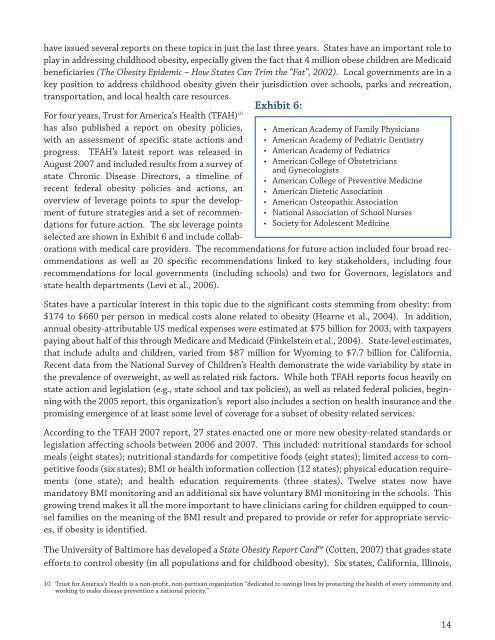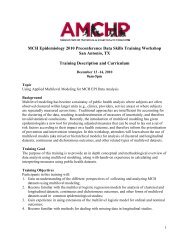Childhood Obesity: The Role of Health Policy - Association of ...
Childhood Obesity: The Role of Health Policy - Association of ...
Childhood Obesity: The Role of Health Policy - Association of ...
You also want an ePaper? Increase the reach of your titles
YUMPU automatically turns print PDFs into web optimized ePapers that Google loves.
have issued several reports on these topics in just the last three years. States have an important role to<br />
play in addressing childhood obesity, especially given the fact that 4 million obese children are Medicaid<br />
beneficiaries (<strong>The</strong> <strong>Obesity</strong> Epidemic – How States Can Trim the “Fat”, 2002). Local governments are in a<br />
key position to address childhood obesity given their jurisdiction over schools, parks and recreation,<br />
transportation, and local health care resources.<br />
For four years, Trust for America’s <strong>Health</strong> (TFAH) 10<br />
has also published a report on obesity policies,<br />
with an assessment <strong>of</strong> specific state actions and<br />
progress. TFAH’s latest report was released in<br />
August 2007 and included results from a survey <strong>of</strong><br />
state Chronic Disease Directors, a timeline <strong>of</strong><br />
recent federal obesity policies and actions, an<br />
overview <strong>of</strong> leverage points to spur the development<br />
<strong>of</strong> future strategies and a set <strong>of</strong> recommendations<br />
for future action. <strong>The</strong> six leverage points<br />
selected are shown in Exhibit 6 and include collab-<br />
Exhibit 6:<br />
• American Academy <strong>of</strong> Family Physicians<br />
• American Academy <strong>of</strong> Pediatric Dentistry<br />
• American Academy <strong>of</strong> Pediatrics<br />
• American College <strong>of</strong> Obstetricians<br />
and Gynecologists<br />
• American College <strong>of</strong> Preventive Medicine<br />
• American Dietetic <strong>Association</strong><br />
• American Osteopathic <strong>Association</strong><br />
• National <strong>Association</strong> <strong>of</strong> School Nurses<br />
• Society for Adolescent Medicine<br />
orations with medical care providers. <strong>The</strong> recommendations for future action included four broad recommendations<br />
as well as 20 specific recommendations linked to key stakeholders, including four<br />
recommendations for local governments (including schools) and two for Governors, legislators and<br />
state health departments (Levi et al., 2006).<br />
States have a particular interest in this topic due to the significant costs stemming from obesity: from<br />
$174 to $660 per person in medical costs alone related to obesity (Hearne et al., 2004). In addition,<br />
annual obesity-attributable US medical expenses were estimated at $75 billion for 2003, with taxpayers<br />
paying about half <strong>of</strong> this through Medicare and Medicaid (Finkelstein et al., 2004). State-level estimates,<br />
that include adults and children, varied from $87 million for Wyoming to $7.7 billion for California.<br />
Recent data from the National Survey <strong>of</strong> Children’s <strong>Health</strong> demonstrate the wide variability by state in<br />
the prevalence <strong>of</strong> overweight, as well as related risk factors. While both TFAH reports focus heavily on<br />
state action and legislation (e.g., state school and tax policies), as well as related federal policies, beginning<br />
with the 2005 report, this organization’s report also includes a section on health insurance and the<br />
promising emergence <strong>of</strong> at least some level <strong>of</strong> coverage for a subset <strong>of</strong> obesity-related services.<br />
According to the TFAH 2007 report, 27 states enacted one or more new obesity-related standards or<br />
legislation affecting schools between 2006 and 2007. This included: nutritional standards for school<br />
meals (eight states); nutritional standards for competitive foods (eight states); limited access to competitive<br />
foods (six states); BMI or health information collection (12 states); physical education requirements<br />
(one state); and health education requirements (three states). Twelve states now have<br />
mandatory BMI monitoring and an additional six have voluntary BMI monitoring in the schools. This<br />
growing trend makes it all the more important to have clinicians caring for children equipped to counsel<br />
families on the meaning <strong>of</strong> the BMI result and prepared to provide or refer for appropriate services,<br />
if obesity is identified.<br />
<strong>The</strong> University <strong>of</strong> Baltimore has developed a State <strong>Obesity</strong> Report Card (Cotten, 2007) that grades state<br />
efforts to control obesity (in all populations and for childhood obesity). Six states, California, Illinois,<br />
10 Trust for America’s <strong>Health</strong> is a non-pr<strong>of</strong>it, non-partisan organization “dedicated to savings lives by protecting the health <strong>of</strong> every community and<br />
working to make disease prevention a national priority.”<br />
14



